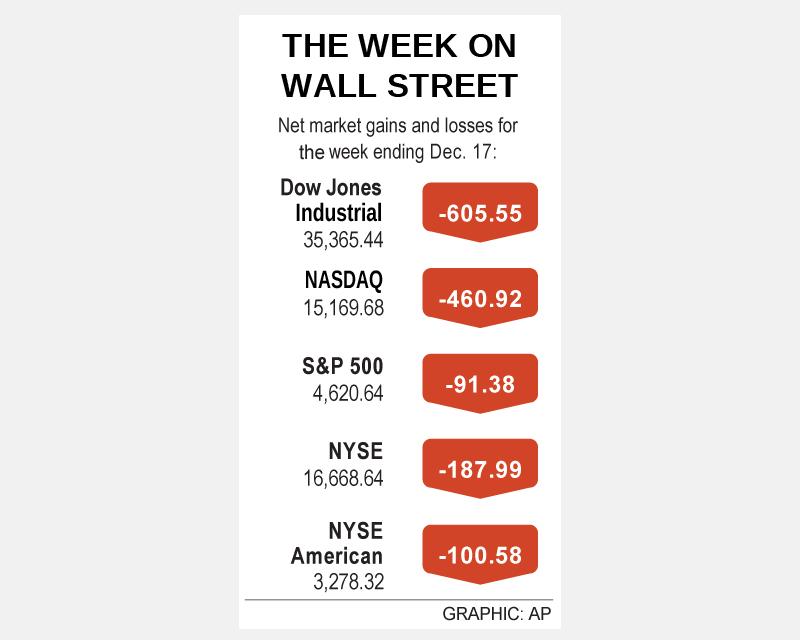Wall Street finished lower on Friday, weighed down by Big Tech as investors worried about the Omicron variant of SARS-CoV-2 and digested the US Federal Reserve’s decision to end its COVID-19-era stimulus faster.
All three main US indices declined for the week after the Fed on Wednesday signaled three quarter-percentage-point interest rate hikes by the end of next year to combat surging inflation.
Nvidia Corp dropped 2.1 percent and Alphabet Inc lost 1.9 percent, both weighing on the S&P 500 and NASDAQ.

Photo: Reuters
The S&P 500 growth index lost 0.7 percent and the value index declined 1.4 percent.
All of the 11 major S&P 500 sector indices fell, with financials leading the way down with a 2.3 percent drop. Energy lost 2.2 percent.
Adding to uncertainty, Pfizer Inc on Friday said that the COVID-19 pandemic could extend through next year.

European countries geared up for further travel and social restrictions and a study said that the rapidly spreading Omicron variant was five times more likely to reinfect people than the Delta variant.
Traders also pointed to year-end tax selling and the simultaneous expiration of stock options, stock index futures and index options contracts — known as triple witching — as potential causes for volatility.
“It’s a big options expiration day, and now you draw on top of that some Omicron, and you’ve got volatility, and I think it creates a lot of uncertainty amongst investors,” said Joe Saluzzi, comanager of trading at Themis Trading in Chatham, New Jersey. “Where are you going to position for the end of the year?”
Heavyweight growth stocks including Nvidia and Microsoft Corp have outperformed the broader market this year, while the Philadelphia SE Semiconductor index has surged about 35 percent.
The benchmark S&P 500 index gained around 23 percent over the same period.
In Friday’s session, the Dow Jones Industrial Average fell 1.48 percent to close at 35,365.44 points, while the S&P 500 lost 1.03 percent to 4,620.64, and the NASDAQ Composite dropped 0.07 percent to 15,169.68.
On a positive note, the small-cap Russell 2000 index rallied 1 percent after having fallen more than 10 percent from a record high early last month.
With options expiring, volume on US exchanges jumped to 16.6 billion shares, far above the 11.9 billion average over the past 20 trading days.
For the week, the S&P 500 dropped 1.94 percent, the Dow lost 1.68 percent and the NASDAQ declined 2.95 percent.
Declining issues outnumbered advancing ones on the NYSE by a 1.50-to-1 ratio; on the NASDAQ, a 1.16-to-1 ratio favored advancers.
The S&P 500 posted 22 new 52-week highs and seven new lows; the NASDAQ Composite recorded 28 new highs and 341 new lows.

The US dollar was trading at NT$29.7 at 10am today on the Taipei Foreign Exchange, as the New Taiwan dollar gained NT$1.364 from the previous close last week. The NT dollar continued to rise today, after surging 3.07 percent on Friday. After opening at NT$30.91, the NT dollar gained more than NT$1 in just 15 minutes, briefly passing the NT$30 mark. Before the US Department of the Treasury's semi-annual currency report came out, expectations that the NT dollar would keep rising were already building. The NT dollar on Friday closed at NT$31.064, up by NT$0.953 — a 3.07 percent single-day gain. Today,

‘SHORT TERM’: The local currency would likely remain strong in the near term, driven by anticipated US trade pressure, capital inflows and expectations of a US Fed rate cut The US dollar is expected to fall below NT$30 in the near term, as traders anticipate increased pressure from Washington for Taiwan to allow the New Taiwan dollar to appreciate, Cathay United Bank (國泰世華銀行) chief economist Lin Chi-chao (林啟超) said. Following a sharp drop in the greenback against the NT dollar on Friday, Lin told the Central News Agency that the local currency is likely to remain strong in the short term, driven in part by market psychology surrounding anticipated US policy pressure. On Friday, the US dollar fell NT$0.953, or 3.07 percent, closing at NT$31.064 — its lowest level since Jan.

The New Taiwan dollar and Taiwanese stocks surged on signs that trade tensions between the world’s top two economies might start easing and as US tech earnings boosted the outlook of the nation’s semiconductor exports. The NT dollar strengthened as much as 3.8 percent versus the US dollar to 30.815, the biggest intraday gain since January 2011, closing at NT$31.064. The benchmark TAIEX jumped 2.73 percent to outperform the region’s equity gauges. Outlook for global trade improved after China said it is assessing possible trade talks with the US, providing a boost for the nation’s currency and shares. As the NT dollar

The Financial Supervisory Commission (FSC) yesterday met with some of the nation’s largest insurance companies as a skyrocketing New Taiwan dollar piles pressure on their hundreds of billions of dollars in US bond investments. The commission has asked some life insurance firms, among the biggest Asian holders of US debt, to discuss how the rapidly strengthening NT dollar has impacted their operations, people familiar with the matter said. The meeting took place as the NT dollar jumped as much as 5 percent yesterday, its biggest intraday gain in more than three decades. The local currency surged as exporters rushed to